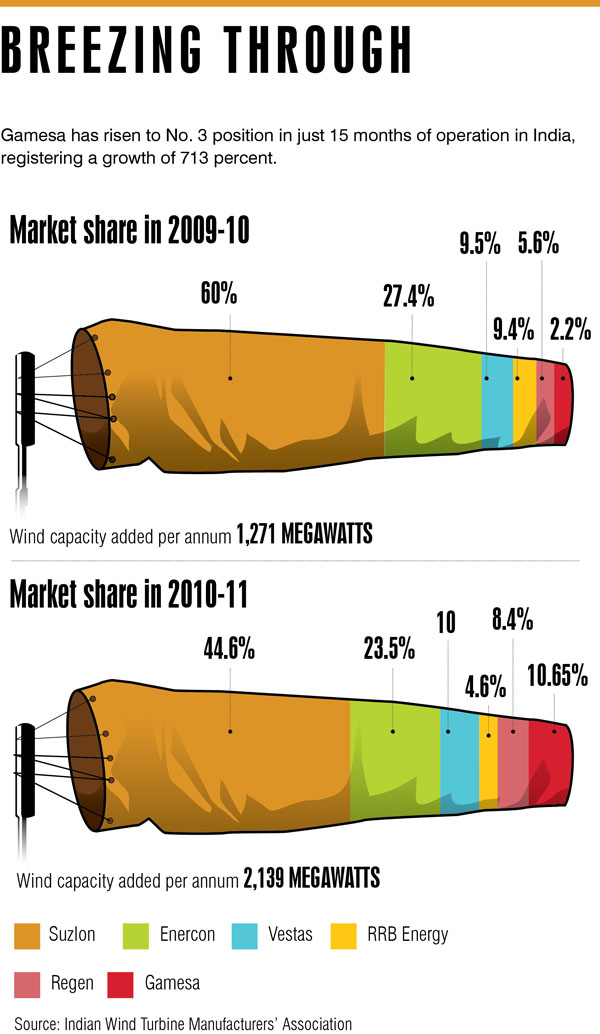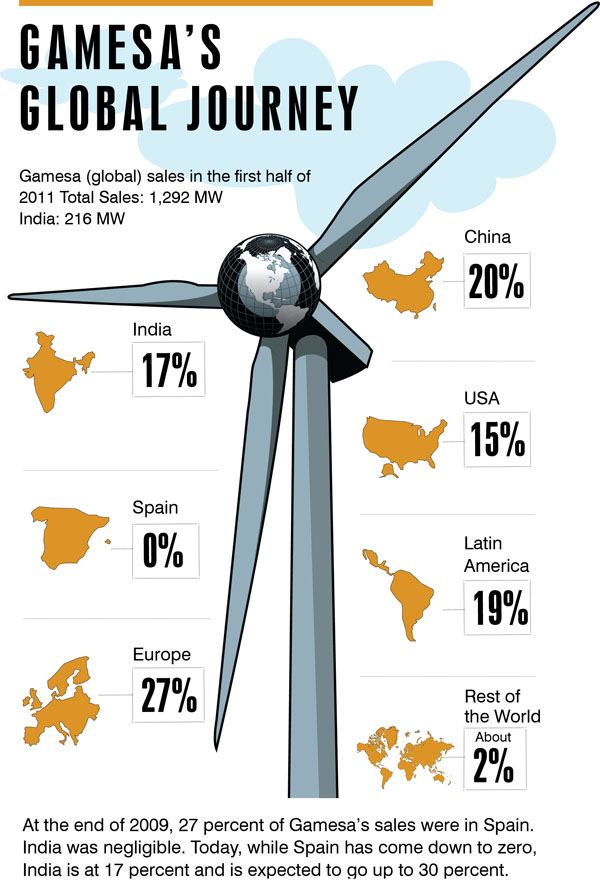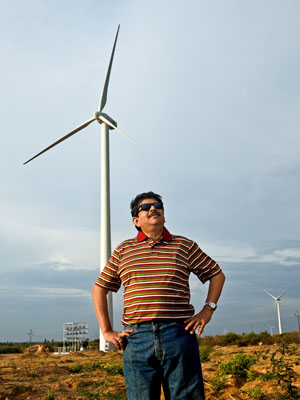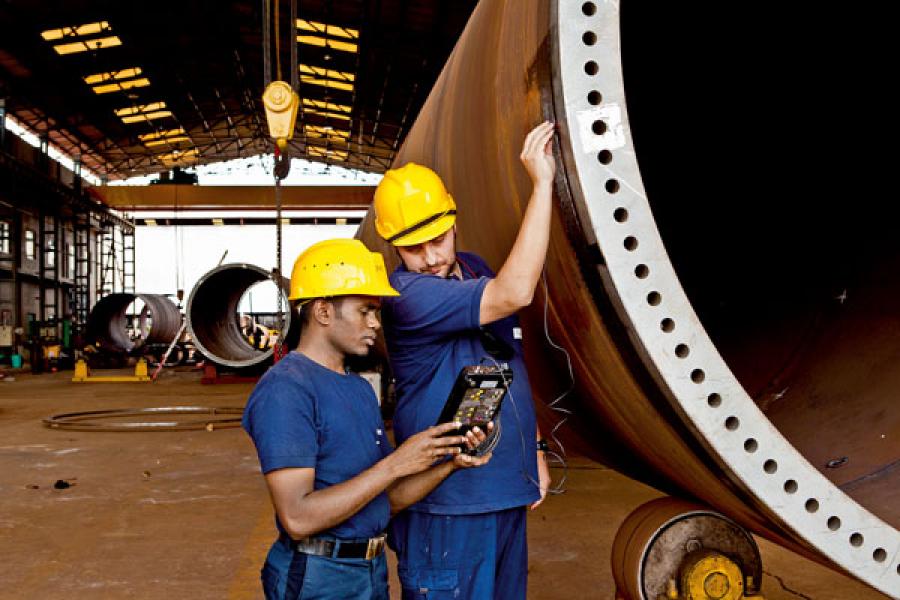
Second Wind for Gamesa
Three years ago, when its home market in Europe all but collapsed, Spanish wind turbine maker Gamesa turned its attention to India, and in the process, discovered a whole new lease of life
In early 2009, Ramesh Kymal got a phone call that changed his life. Kymal was then the managing director of the Indian subsidiary of Vestas, the biggest wind turbine maker in the world. For the past five years, Kymal had tried and failed to convince his bosses in Denmark that he needed new investments in India. Eventually, he gave up and decided to move on. Yet, after six long months of negotiations, just when he was on the verge of joining Siemens, he received a call from Richard Chocarro.
What the chief operating officer of the $4 billion Gamesa Corporation told him was music to Kymal’s ears. Chocarro wanted him to build the Indian business from scratch and set up a local manufacturing and supply chain operation. And the deal clincher: He would report directly to the executive committee in Spain — without having to deal with the bureaucracy of an Asia Pacific chain of command based in Singapore, like at Vestas.
Kymal couldn’t contain his excitement. “This was the answer to most of my big disagreements with my previous employer. I gave my consent almost instantaneously. Within two weeks, I went to Spain, we signed up and it was done,” says Kymal, who has now spent 24 months at the helm as the managing director of Gamesa India.
In that time, he’s turned Gamesa into the player to watch in India’s burgeoning wind energy market. The firm has emerged as the third biggest player with a 10 percent share in a market, dominated by local maker Suzlon and a host of multinationals like Vestas, Enercon, Siemens and GE sitting on the fringes (see graphic on Page 55).
By next year, if Kymal’s plans pan out the way that he hopes, he could overtake his former employer Vestas as well. Already, Gamesa’s existing manufacturing capacity in Chennai is sold out for the year, he claims. And Gamesa is likely to close this fiscal with installations of 550 MW, a 100 percent growth over last year. By next year, Kymal aims to almost double the share of India’s contribution to Gamesa’s global top-line from the current 17 percent to 30 percent.
Behind this surge lies an untold story of how the Spanish multinational shifted its centre of gravity from the developed markets of Europe and the US and hunkered down in the emerging markets of China, India and Brazil. In many ways, Jorge Calvet, its chairman and CEO, did what a lot of Gamesa’s rivals were unable to push through: He began shutting down manufacturing and R&D (research and development) resources in Spain and shifted them to low-cost destinations like India. He devolved greater powers to local managers like Kymal and backed them with innovation resources and investments.
Now, it wasn’t as if Calvet had much of a choice either.
A New Reality
Calvet, 54, who graduated with an MBA in finance from the Stern School of Business, had spent much of his investment banking career with Morgan Stanley, UBS and Fortis. In 2009, Gamesa invited him to take over as its chairman. “I was an independent board member of Gamesa since 2005 and the board asked me to take up this challenge and I thought it would be a very interesting challenge to run an industrial company,” he says. But the timing couldn’t have been worse.
The financial meltdown of 2008 turned the wind energy business on its head. Between 2006 and 2008, the wind energy market was driven by huge demand in Europe and the US. Pumped up by the talk around climate change, clean energy and government subsidies, power utilities were looking for wind turbines to fulfill their large programmes of investment. If you were a wind turbine manufacturer you could even pre-sell every turbine you manufactured. But when the downturn hit in 2008, orders were cancelled or postponed.
Gamesa Corporation found itself in a tight spot. Till about 2008, Spain, its home market and Europe constituted about 50 percent of its sales. And now just like that, all of it dried up. Compared to its competitors, Gamesa felt the pinch even more since it didn’t have any products in the off-shore segment, the only segment which was growing marginally. “Only at the end of 2009, 35 percent of our sales were in Spain. Today, as we speak, our sales in Spain are exactly zero. We do not sell anything there,” says Calvet.
In 2009, Gamesa Corporation’s sales fell by 16 percent and the company reported a net profit of €115 million, compared to €177 million in 2008. Looking back, Calvet says the crisis taught him a big lesson. “You have to diversify your risks from a geographical and customer point of view. This is because the world never goes in sync, not all the economies are synchronised. Some fall behind, others move ahead,” he says. So, while demand in Asia and Latin America have surged, Western Europe and the US have fallen behind.
Now, the entry into the Indian market became critical for yet another reason. Like many other multinationals, Gamesa had discovered the Chinese market way back in 2005. It had invested in local factories and localised more than 70 percent of its components. Initially, it had a superb run, sewing up about a third of the market.
In the latter half of the last decade, China’s wind energy sector shot through the roof. After four years of doubling its installed wind capacity, a record capacity of 16.5 GW was added to the Chinese wind fleet in 2010, taking the total up to 42.3 GW, which makes China the country with the largest installed wind energy capacity in the world. With the boom came competition, especially the Chinese themselves.
Multinational firms like Gamesa and Vestas helped create the low cost production base and transferred manufacturing skills to its local partners and suppliers. But the gains eventually went to three local companies Sinovel, Goldwind and Dongfang Electric, which today have a combined market share of more than 60 percent. A recent New York Times article argues that the state granted preferential treatment to local firms. Whatever be the real reason, though Gamesa still sells more turbines in China than it used to in 2005, its market share is down to around 3 percent.
The Go-Global Mantra
Calvet responded to the crisis by driving the expansion strategy. In 2010 alone, Gamesa entered 10 new countries adding 22 new customers. But entering a new market with a product from an existing portfolio is just one challenge. A significant part of any successful globalisation initiative rests on getting the organisation ready for it. Calvet ensured that process started at his door. He ensured that the global executive committee travelled to each market.
Another important step was to build a lean structure which speeded up decision making and gave it an edge over its competitors. For instance, Gamesa’s entry into Brazil took nine months from start to finish. “I figure that it is important to empower your executives to take the right decision and we trust them. We don’t go through endless committees to move things forward,” he adds.
It helps that Calvet is pretty clear on how he wants to run Gamesa. He swears by the mantra ‘to have very clear ideas of what you are going to achieve with your company in a certain region.’ “And unless I see something that I don’t understand or don’t agree with fully, I let the teams run it,” he adds.
This change process also meant taking some tough decisions back home. In the last two years, Gamesa went on a mission to reduce the headcount, cutting down its manufacturing output in Spain almost by half and increasing sourcing from low cost component suppliers in China — a process which has so far saved the corporation €250 million. “Secondly, by shifting manufacturing capacity from Spain to other countries like China, India and Brazil, we are able to lower our cost base,” adds Calvet.
The India Strategy
The mantle of boot-strapping the Indian business lay with Kymal. With 17 years of experience in the wind energy business, he had both the market understanding and the client relationships in place. His strategy was built around three pillars: Cost efficiency, market segmentation with different product offerings and innovative ideas.

In the beginning, like most multinational companies, the company used to rely heavily on imports — an expensive process. To cut down on the cost, the company began to scout for local suppliers from whom they could buy components.
“In a matter of just one year, we have been able to localise 40 percent of the components. So, by February 2010, we were already significantly lower in terms of our cost which we passed on to our customers and we are targeting 70 percent by the end of this year,” says Kymal.
In March this year, Gamesa also announced that it would be setting up a R&D centre in Chennai to support its global engineering and research activities, as part of its strategy to localise its products and employ Indian engineers to work on product technology, materials, design and production processes to cater to the Indian market.
Gamesa has learnt from its China experience that building a strong supplier base was the key to being cost competitive. Now, it’s employing similar tactics in Brazil and India as well. “I know exactly what I want to achieve in India and that helps taking decisions and moving things fast,” says Calvet.
However, local manufacturing has its downside. Getting hold of quality manufacturers is a time-consuming process. For instance, in the case of Larsen & Tubro (L&T), which supplies castings to Gamesa, both companies worked together for more than 15 months before L&T became an approved supplier.
Similarly, it took a good one year for the company to develop a supplier for nacelle covers suitable for its turbines. Gamesa’s nacelle assembly plant is at Red Hills, 35 km from Chennai.
As one enters the plant, on the left is a giant board which measures the efficiency of operations. But what catches one’s eye are the factory rejects. “Right now, that is one of our biggest challenges,” says Sanju Davis, the plant manager. “We are importing bearings from China and Spain because there are no Indian companies who can supply bearings that go into a wind turbine,” he says. To tackle quality issues, Gamesa now has three to five quality auditors at every supplier’s manufacturing location.

Besides localising, Gamesa is also creating a market where none exists. Kymal is looking at wind turbines that were installed in the 1990s. These turbines, manufactured by European companies were designed for European wind conditions. As a result, the full potential of these turbines have not been realised. Kymal wants to uproot the old installations and put in place turbines that are designed for Indian wind conditions. He is trying to convince investors that it is more profitable to install new turbines than run the old ones. So far, he has bagged two projects of 10 MW. He is hopeful that he will be able to make more inroads in this market he creates.
Kymal’s big bet, however, is in investing behind the integrated power producers (IPP), who are looking for the intrinsic merits of the technology, rather than the traditional depreciation customer who buys a turbine for the tax rebates it offers. “Two years from now, I don’t think there will be any depreciation customer. I have learnt it the hard way that getting an IPP is a completely different ball game,” says Kymal.
That’s why he divided the sales force into two groups: One for depreciation customers and the other for IPPs. Depreciation customers want the product quickly. Their waiting period is 6-8 weeks and price is not an issue.
IPPs are the exact opposite. They spend months on negotiations before deciding to buy a wind turbine. They also want wind data for the site where they plan to install the turbine. Kymal says he now has his plant, R&D, marketing and sales teams specifically focussed on grabbing IPPs.
Additionally, with the Central and state governments’ incentive to customers who use wind energy to generate power, Gamesa seems to be on the right track, especially after clinching the Caparo deal, the biggest such deal in recent years. And though Suzlon also bit off a part of the deal, for Gamesa, signing the 2,000 MW power project, has been a turning point. A project of this size was what the company needed to give it a fillip in India.
“The Caparo Energy deal took us a year and a half to negotiate. You have to have real professionals on your team — lawyers, marketing, technical experts and they are not easy to get. And to provide those answers, you have to be convinced about it yourself first. That’s why Gamesa is putting up wind maps so that we can give the wind data to prospective IPPs,” says Kymal.
Caparo also believes that the market is slanting towards IPPs. “To us it is fairly clear that the Indian wind energy market is on the cusp of a major transformation,” says Ravi Kailas, managing director of Caparo. The company is setting up wind farms of about 3000 MW in the country by 2016 and Gamesa is part of this project. “What clicked for us with Gamesa is the professionalism with which they went about the whole process, leaving no room for ambiguity,” says Kailas.
Moreover, Kymal is betting on a total solution. Gamesa buys land, get permits from local authorities, identifies wind sites and sets up the wind farm for its customer. So far, the other multinationals haven’t geared up for the shift. “Large European companies in India are not flexible. For instance, they will not sell to smaller guys and never below a certain rate. They don’t want to compete for business,” says V.K. Krishnan, executive director at Leitner Shriram, a wind turbine manufacturing company.
With renewable energy poised for a new lease of life in a an economy where energy requirements have gone up ten-fold, Gamesa seems to be on a strong footing. And with a total of Rs. 1,500 crore locked in investments in India, Calvet and Kymal, while banking on big growth, might also be keeping their fingers crossed. They wouldn’t want the Indian experience to go the China way.
(This story appears in the 23 September, 2011 issue of Forbes India. To visit our Archives, click here.)
-
 Dr.a.jagadeesh
Dr.a.jagadeeshGamesa is fast emerging as a potential wind turbine provider in India. It was a success in Spain. Dr.A.Jagadeesh Nellore(AP),India Wind Energy Expert
on Sep 9, 2013 -
 Shanmugham Kangala
Shanmugham KangalaGamesa had a tie up with a Indian Co. in 2005, but could not make any significant progress. The technology was the same, field proven and latest but the business model did not suit India. Team members in the JV could not deliver the result. It is the same product now after five years, but a different marketing model managed by experienced competent professionals could set up the records.
on Sep 20, 2011 -
 Praveen Pandey
Praveen PandeyGood1.......inspirational...keep it up
on Sep 20, 2011 -
 Mayukhm@yahoo.com
Mayukhm@yahoo.comGreat article. Reiterates the points, u have to believe in India and Indian professionals....Also cost is always the only decision in buying..!!
on Sep 17, 2011
















